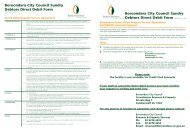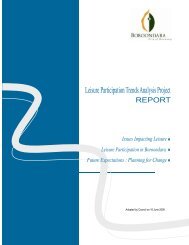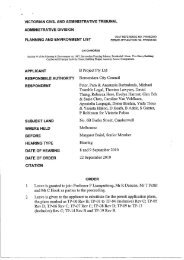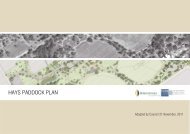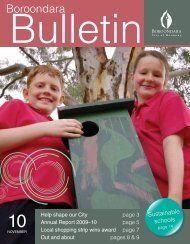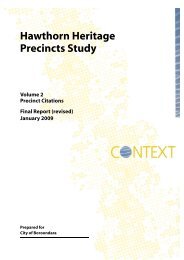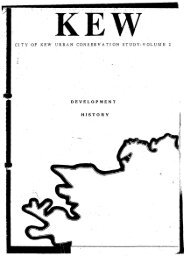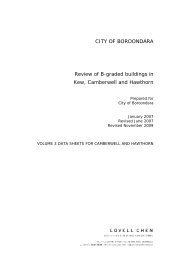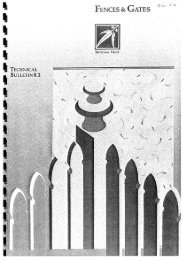Camberwell Conservation Study 1991 Vol 3 - City of Boroondara
Camberwell Conservation Study 1991 Vol 3 - City of Boroondara
Camberwell Conservation Study 1991 Vol 3 - City of Boroondara
You also want an ePaper? Increase the reach of your titles
YUMPU automatically turns print PDFs into web optimized ePapers that Google loves.
ages, for the views and to allow for motor traffic). These<br />
specially formed corner blocks added two blocks per<br />
corner and allowed a diagonal siting axis for each house.<br />
Percentages <strong>of</strong> identified house construction dates in the<br />
period 1916-30 are as follows:<br />
Highgate Grove 57%<br />
Lexia Street 59%<br />
Munro Avenue 49%<br />
Ward Street 37%<br />
Highgate and Lexia both have over 90% inter-war housing<br />
representing <strong>of</strong> the street whileMunro and Ward are<br />
49% and 80% respectively. Distribution <strong>of</strong> period is<br />
predictably earlier housing (pre 1930) closer to High<br />
Street tram line. In the Ashburton Shopping Centre itself<br />
there is the same period distribution adjoining the estate,<br />
with more emphasis on the late 1930s; i.e., 180-82<br />
(c1937), 206-212High Street (c1939). Opposite there are<br />
rows <strong>of</strong> 1920s shops, (243-259High Street): both periods<br />
providing visually cohesive elevations.<br />
Historic Themes:<br />
(iii) transport links and modes and their impact on residential<br />
and commercial development<br />
(v) typical residential lifestyles and their physical expression<br />
(iv) man-made and 'native' landscape, their evolution<br />
Description<br />
Munro Avenue<br />
This street has late 1920s, 1930s houses. There are a<br />
number <strong>of</strong> intrusions with new development but some<br />
Moderne style houses, some Mediterranean villa style,<br />
and some Old English style survive.<br />
Highgate Street<br />
The street has a concrete roadway with the name <strong>of</strong> the<br />
street set into the roadway. Camphor Laurel trees help<br />
create a distinct character <strong>of</strong> late 1920s, early 1930shousing<br />
(Italian villaor Mediterranean villa,such as Numbers<br />
19 and 21), with some Bungalow era housing like Numbers<br />
23 and 26.<br />
Lexia Street<br />
The street has a concrete roadway, Bungalow style<br />
houses, Old English and Mediterranean villa mixture,<br />
mainly stuccoed and brick housing with some original<br />
fences.<br />
DentStreet<br />
North face only in Precinct with mainly Mediterranean<br />
villa style houses <strong>of</strong> masonry and stucco and some Old<br />
English.<br />
Ward Street<br />
The street has a concrete roadway, with the name set into<br />
the road. There is 1930shousing, brick and stucco using<br />
the Moderne (Number 33) and Old English styles.<br />
High Street<br />
The commercial frontage is<strong>of</strong> a similarera, albeit altered.<br />
Significance<br />
A range <strong>of</strong> 1920s-30s house styles with high integrity to<br />
the initiation date <strong>of</strong> the estate which is enhanced by<br />
concrete roads, street trees and an adjoining contempo-<br />
<strong>Camberwell</strong> <strong>Conservation</strong> <strong>Study</strong> <strong>1991</strong> - Significant Areas<br />
rary shopping strip. Historically it represents the high<br />
growth period in the 1920sand the influence <strong>of</strong>transport<br />
on itslocation also the effort takenbydevelopers to create<br />
a distinct character with road surfacing, streettree selection<br />
and street name identification.<br />
The precinct is important in expressing the character <strong>of</strong><br />
subdivisionin the southern parts <strong>of</strong> the municipality in the<br />
1920s and 19305. The area has a high proportion <strong>of</strong><br />
typical housing styles<strong>of</strong> the period, supported by characteristic<br />
street features. Of additional interest are the size<br />
<strong>of</strong> corner blocks and diagonal building sitirlg (reflecting<br />
by-law planning) and the relation <strong>of</strong> the houses to the<br />
shopping centre. The shopping centre itself retains the<br />
character <strong>of</strong> the subdivision period in several rows <strong>of</strong><br />
shops and is significant in reflecting the rolelink between<br />
transport, home and shopping, the characteristic grouping<br />
<strong>of</strong> land uses in the inter-War suburb.



